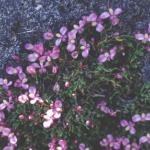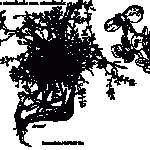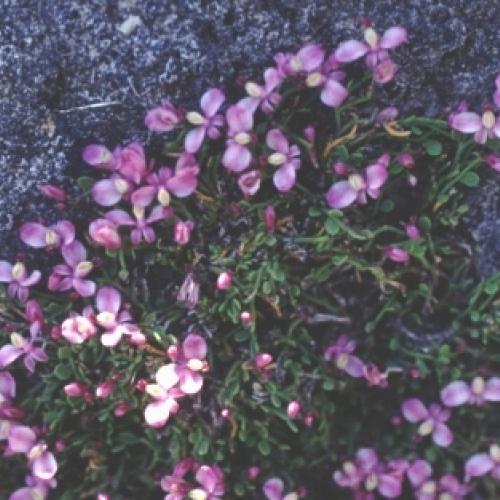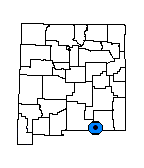Rhinotropis rimulicola var. rimulicola (Guadalupe Milkwort)
Family
POLYGALACEAE
Synonyms
NONE
Common Name
Guadalupe Milkwort
| USFWS | State of NM | USFS | BLM | Navajo Nation | State Rank | Global Rank | R-E-D Code | NMRPTC Status | Strategy Status |
|---|---|---|---|---|---|---|---|---|---|
| S2 | G3T3 | 2-1-2 | R | SS |
| Overall Conservation Status | Documented Threats | Actions Needed |
|---|---|---|
| MODERATELY CONSERVED | No Information |
monitor population trends |
Description
Mat-forming perennial herb from a woody base; stems numerous, glabrous, slender, mostly prostrate, branching, 1-5 cm long, green; leaves ovate-elliptic, 1.5-4 mm long, slightly fleshy; flowers 1 or 2, at the ends of branches, rose-purple and white; pedicels at maturity recurved and nodding, 2 mm long; wing petals broadly ovate, 4 mm long and 2.5 mm wide; keel petal, pouch-shaped, 3 mm long, obscurly beaked or beak lacking, greenish yellow; capsule broadly oval, 2 mm long, sparingly covered with short incurved hairs; seeds silvery pubescent, aril forming a glabrous knob on one end. Flowers June through September.
Similar Species
The prostrate, green, glabrous, nonglandular stems of Polygala rimulicola readily distinguish it from other New Mexican species in the genus. Its nearly beakless keel petal separates it from P. rimulicola var. mescalerorum.
Distribution
New Mexico, Eddy County, Guadalupe Mountains; adjacent Texas, Sierra Diablo and Guadalupe mountains.
Habitat
Crevices in limestone cliffs in montane scrub to lower montane coniferous forest; 1,550-2,400 m (5,000-8,000 ft).
Remarks
In New Mexico, this plant is restricted to the relatively cool, shaded canyon walls of the Guadalupe Escarpment. Even within this habitat it is sporadic and uncommon. It shares this habitat with several other narrow endemics such as Hedeoma apiculata, Salvia summa, Nama xylopodum, Aquilegia chaplinii, Chaetopappa hersheyi, and Perityle quinqueflora.
Conservation Considerations
The rugged, inaccessible nature of this plant's habitat protects it from any impacts of land use.
Important Literature
*New Mexico Native Plants Protection Advisory Committee. 1984. A handbook of rare and endemic plants of New Mexico. University of New Mexico Press, Albuquerque.
Steyermark, J.A. 1932. Some new spermatophytes from Texas. Annals of the Missouri Botanical Garden 19:289-395.
Information Compiled By
Robert Sivinski 1999
For distribution maps and more information, visit Natural Heritage New Mexico




